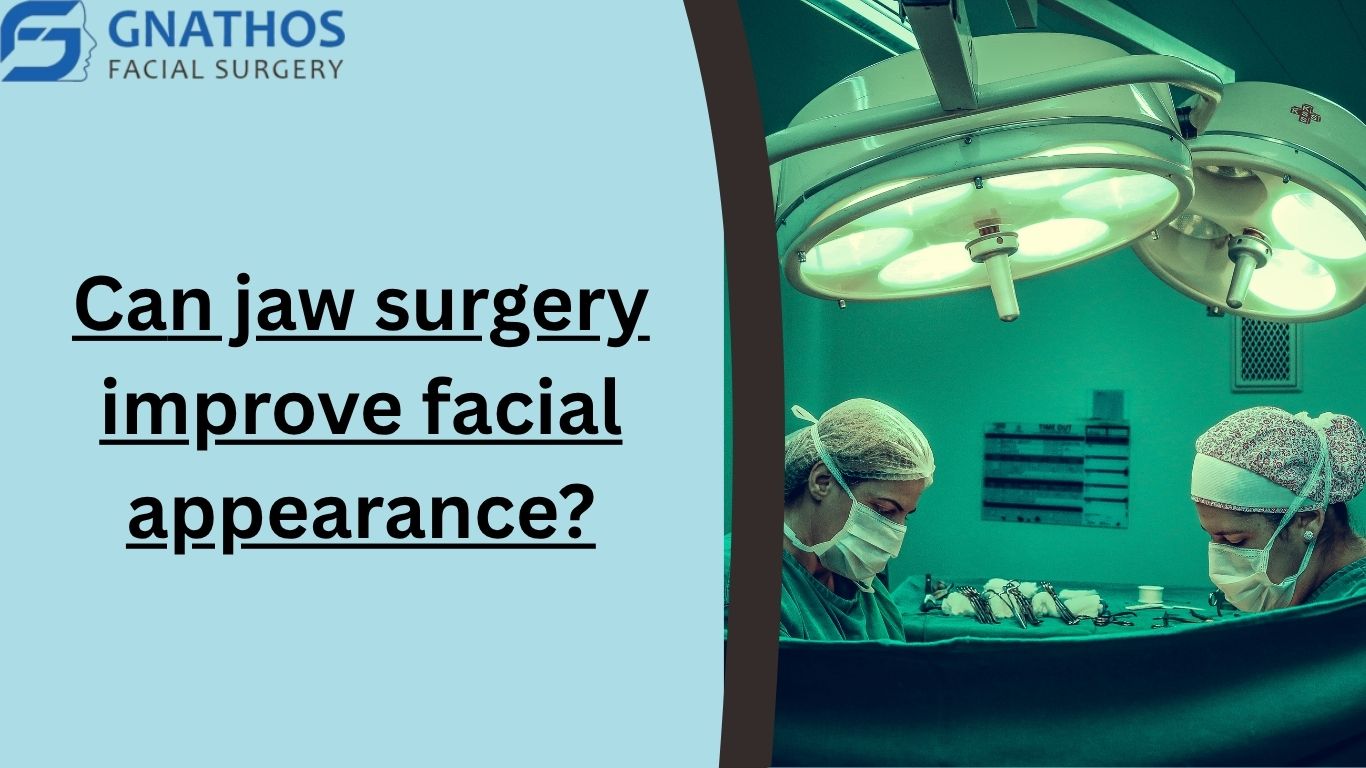If you’re considering jaw surgery, you’re likely focused on the functional benefits—fixing a painful bite, relieving chronic jaw strain, or addressing a breathing issue like sleep apnea. But let’s be honest, there’s another question quietly lurking in your mind: “Can jaw surgery improve facial appearance?“
It’s a completely valid and natural concern! Your jaw structure is the foundation of your entire face. When your upper or lower jaws are misaligned, underdeveloped, or overgrown, it affects the harmony of your features, impacting your profile, your chin, and the way your nose and lips look in relation to one another. The good news is that for the right candidates, jaw surgery—specifically orthognathic surgery (corrective jaw surgery)—is designed to be both functional and aesthetic. In fact, improving facial balance is often a key goal of the procedure.
Today, we’re going to dive into the powerful connection between jaw position and facial aesthetics. We’ll explore exactly why and can jaw surgery improve facial appearance, looking at how correcting underlying skeletal issues leads to a more balanced and harmonious look. We’ll cover the specific aesthetic changes you can expect and the detailed planning that makes these transformations possible. Let’s uncover the life-changing potential of this surgery together!
The Primary Goal: Function First, Aesthetics Follow

It’s important to start with the foundational purpose of jaw surgery. Orthognathic surgery is, first and foremost, a reconstructive procedure. It’s medically necessary to correct functional issues that affect your health and quality of life. These functional problems include:
- Malocclusion (Bad Bite): Correcting a severe underbite, overbite, or crossbite that cannot be fixed with orthodontics alone.
- Chewing and Speaking Issues: Improving the ability to chew food properly and articulate words clearly.
- Chronic Jaw Pain (TMD): Alleviating chronic strain caused by an ill-fitting bite.
- Sleep Apnea (OSA): Advancing the jaw to open a blocked airway (Maxillomandibular Advancement, or MMA).
The fantastic truth is that because the facial skeleton dictates the position of the soft tissues (the muscles, lips, and skin), fixing the functional skeletal problem inherently results in a significant and often dramatic aesthetic improvement. The jaw surgery doesn’t just treat a disease; it rebalances the entire lower and mid-face.
Can Jaw Surgery Improve Facial Appearance?
Yes — jaw surgery not only corrects bite or alignment issues but can also enhance your overall facial balance and symmetry. By repositioning the jaw, our facial surgeons help create a more harmonious profile and natural facial proportions for lasting results.
Schedule a Jaw Surgery ConsultationCan Jaw Surgery Improve Facial Appearance? Specific Aesthetic Changes
The answer to “Can jaw surgery improve facial appearance?” depends entirely on the specific misalignment being corrected. Orthognathic surgery corrects skeletal issues that are typically categorized as one of the following:
1. Correcting the Underbite (Mandibular Prognathism)
In an underbite, the lower jaw is positioned too far forward, making the chin and lower lip appear overly prominent.
- Functional Goal: To pull the lower jaw back into alignment with the upper jaw, allowing the upper teeth to overlap the lower teeth correctly.
- Aesthetic Improvement:
- Reduced Chin Prominence: The profile becomes softer, moving the chin back to a more balanced position under the forehead.
- Improved Lip Seal: The lower lip often relaxes into a more natural, less tense position.
- Less “Hollow” Midface: In complex cases, moving the upper jaw forward slightly along with the lower jaw can improve the support under the cheeks.
2. Correcting the Overbite/Recessed Jaw (Mandibular Retrognathia)
In a severely recessed jaw, the lower jaw is positioned too far back, giving the appearance of a “weak chin” and making the nose appear larger and the neck tissue appear loose.
- Functional Goal: To bring the lower jaw forward to meet the upper jaw correctly (a procedure known as Mandibular Advancement).
- Aesthetic Improvement:
- Stronger Jawline and Chin: This is often the most dramatic change. Advancing the mandible creates a stronger, better-defined jawline and chin projection, which significantly balances the profile.
- Improved Neck Angle: The forward movement pulls the overlying soft tissues and muscles (like the genioglossus muscle attached to the tongue) forward, improving the cervico-mental angle (the angle between the neck and the chin) and reducing the appearance of a “double chin.”
- Nose/Lip Balance: The face achieves better harmony because the chin is no longer recessed relative to the nose and lips.
3. Correcting Open Bite and Facial Height
In an open bite, the back teeth meet, but the front upper and lower teeth don’t touch, often making the face look long (long face syndrome).
- Functional Goal: To move the upper jaw upward and often slightly forward (Maxillary Impaction) to rotate the lower jaw closed, correcting the open bite.
- Aesthetic Improvement:
- Reduced Facial Height: Shortening the mid-face region visually shortens the face, improving proportion and balance.
- Reduced Gum Show: Minimizes the appearance of excessive gum tissue when smiling (“gummy smile”).
- Lip Harmony: The lips can close more naturally without straining, resulting in a more relaxed and aesthetically pleasing appearance at rest.
4. Correcting Asymmetry
Facial asymmetry occurs when the jaws or chin are misaligned, causing the features on one side of the face to appear different from the other.
- Functional Goal: To level the jawline and ensure the midline of the upper and lower jaws match the midline of the face.
- Aesthetic Improvement: The surgeon moves the jaws so that the features of the face—especially the chin, jaw angles, and lip line—are symmetrical, leading to a much more balanced overall facial appearance.
The Art and Science of Surgical Planning
The success of jaw surgery in achieving both functional correction and aesthetic improvement relies entirely on highly sophisticated pre-surgical planning. This is where the artistry and science of the Oral and Maxillofacial Surgeon (OMS) truly shine.
1. Orthodontics First
Jaw surgery is a team effort. The first phase involves orthodontic treatment (braces or clear aligners) to align the teeth within each jaw so that they will fit together perfectly after the surgery. Ironically, the orthodontics often makes the bite look worse before surgery, as the teeth are aligned over the misaligned jaws.
2. Virtual Surgical Planning (VSP)
This is the key to predicting the aesthetic outcome. The OMS uses advanced technology:
- CBCT (Cone Beam CT) Scans: Provide detailed 3D images of the bones and soft tissues.
- 3D Models: The surgeon digitally manipulates the 3D images of the patient’s jaws on a computer screen, moving them to the final planned position.
- Soft Tissue Analysis: The software can simulate how the skin, lips, and chin soft tissues will drape over the new skeletal framework. This allows the surgeon to ensure the aesthetic results are ideal before the patient ever enters the operating room.
The surgeon and the orthodontist collaboratively define the exact skeletal movements (e.g., advancing the lower jaw by 8mm, impacting the upper jaw by 2mm) that will achieve the best functional bite and the most balanced profile.
3. Supplemental Aesthetic Procedures
In some cases, the OMS may combine orthognathic surgery with minor complementary procedures to perfect the aesthetic result:
- Genioplasty (Chin Surgery): After the main jaw movements, the chin bone itself may be repositioned (moved forward, back, or side-to-side) to achieve the ideal final projection and contour.
- Rhinoplasty (Nose Surgery): Moving the upper jaw (maxilla) can sometimes subtly affect the base of the nose. While often positive, a small rhinoplasty may occasionally be necessary to achieve complete facial harmony.
Recovery and Long-Term Aesthetic Changes
The recovery from jaw surgery is a journey that requires patience, but the aesthetic changes are often immediate, though initially hidden by swelling.
- Swelling: The face will be significantly swollen for the first few weeks, obscuring the final result. The swelling typically subsides by 70-80% within the first month.
- Final Result: The last 20% of the swelling takes much longer to resolve, sometimes up to 9-12 months. The final, stable aesthetic result is generally seen around the one-year mark, once the bone has completely healed and the soft tissues have settled into their new position.
- Stability: Once the jawbones heal in their new position, the functional and aesthetic results are generally permanent, offering a lifelong correction to the facial imbalance.
Understanding the deep link between structure and appearance is why consulting with a specialist who views your treatment as a complex functional and aesthetic endeavor is so critical.
For a precise diagnosis and the highest standard of surgical planning that integrates both function and aesthetics, you need an expert Oral and Maxillofacial Surgeon. Professionals like Dr. Suresh are dedicated to using cutting-edge virtual surgical planning to ensure that every movement of the jawbones not only corrects your bite and improves your health but also enhances your facial harmony. To explore how Dr. Suresh can help you achieve a more balanced profile while restoring optimal function. Choosing a specialist with a deep understanding of facial aesthetics is the best way to ensure a life-changing result.
Can Jaw Surgery Improve Facial Appearance?
Yes — jaw surgery not only corrects bite or alignment issues but can also enhance your overall facial balance and symmetry. By repositioning the jaw, our facial surgeons help create a more harmonious profile and natural facial proportions for lasting results.
Schedule a Jaw Surgery ConsultationFrequently Asked Questions (FAQs) About Jaw Surgery and Appearance
Is jaw surgery considered cosmetic since it improves appearance?
No, jaw surgery (orthognathic surgery) is medically classified as a reconstructive procedure because its primary goal is to correct a functional problem, such as malocclusion, breathing difficulties, or chronic pain, caused by a skeletal discrepancy. The aesthetic improvement is considered a beneficial and integrated secondary outcome of correcting the underlying skeletal defect.
Can I get jaw surgery just to improve my appearance without a functional problem?
Generally, orthognathic surgery is not performed purely for cosmetic reasons due to its invasiveness and the complex recovery process. However, if a patient has a severe aesthetic concern related to skeletal imbalance, a surgeon may consider the aesthetic improvement a primary goal, provided the surgery also corrects any existing or potential functional issues.
How long until I see the final aesthetic results after jaw surgery?
While you will see a noticeable change immediately after surgery, the final aesthetic results are not visible until the majority of the swelling has subsided, which typically takes 9 to 12 months. The face requires time for the soft tissues to fully settle and the bones to completely heal in their new, corrected position.
Will moving my upper jaw affect the appearance of my nose?
Yes, moving the upper jaw (maxilla) can subtly affect the base of the nose. If the maxilla is moved forward, the nose may appear slightly wider. If the maxilla is moved upward (impaction), the nose may appear slightly turned up. Surgeons account for these changes during planning and may recommend minor complementary procedures, like a septorhinoplasty, to maintain nasal harmony.
How does jaw surgery create a better chin or jawline?
Jaw surgery, particularly when the lower jaw is advanced, physically moves the bony structure of the chin and jawline forward. This stretches and tightens the overlying soft tissues of the neck, dramatically improving the definition of the jawline and the angle between the chin and the neck, leading to a much stronger and more defined profile.
Do I still need braces after the jaw surgery is done?
Yes, most patients still require a final phase of orthodontic treatment (braces or aligners) after jaw surgery. The surgery aligns the foundation (the jaws), but the post-surgical orthodontics is essential for making minor, final adjustments to the teeth to ensure the bite is perfectly stable, functional, and aesthetically aligned.












